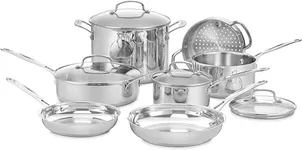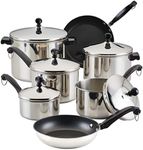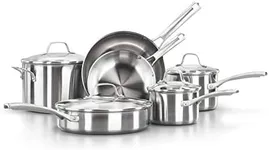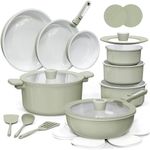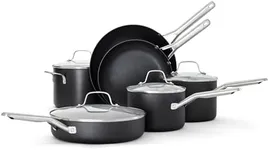Buying Guide for the Best Pot And Pans Sets
Choosing the right pot and pan set can significantly enhance your cooking experience. The right set will not only meet your cooking needs but also last for years, providing good value for your investment. When selecting a pot and pan set, consider the materials, the types of pots and pans included, the compatibility with your stove, and the ease of maintenance. Here are some key specifications to help you make an informed decision.MaterialThe material of pots and pans affects their heat conductivity, durability, and maintenance. Common materials include stainless steel, non-stick, cast iron, and copper. Stainless steel is durable and resistant to rust and staining, making it a good all-around choice. Non-stick pans are great for low-fat cooking and easy cleanup but may not last as long. Cast iron retains heat well and is excellent for searing, but it requires more maintenance. Copper offers excellent heat conductivity but can be expensive and requires regular polishing. Choose a material based on your cooking habits and willingness to maintain the cookware.
Number of PiecesPot and pan sets come in various sizes, typically ranging from 5 to 15 pieces. A basic set might include a couple of saucepans, a frying pan, and a stockpot. Larger sets may include additional pieces like sauté pans, steamer inserts, and more. Consider the types of dishes you frequently cook and the number of people you usually cook for. If you cook a variety of meals, a larger set with more specialized pieces might be beneficial. For simpler cooking needs, a smaller set will suffice.
Heat ConductivityHeat conductivity refers to how evenly and quickly a pot or pan heats up. Materials like copper and aluminum are excellent conductors of heat, ensuring even cooking. Stainless steel, while durable, is not as good a conductor unless it has an aluminum or copper core. Good heat conductivity is important for preventing hot spots and ensuring your food cooks evenly. If you often cook delicate dishes that require precise temperature control, prioritize sets with high heat conductivity.
Stove CompatibilityNot all pots and pans are compatible with every type of stove. For example, induction cooktops require magnetic cookware, while gas stoves work with most types. Check the manufacturer's specifications to ensure the set you choose is compatible with your stove. If you have an induction cooktop, look for sets labeled as induction-compatible. For other stove types, you have more flexibility, but it's still worth considering how the cookware will perform on your specific stove.
Oven SafetySome pots and pans are designed to be used in the oven as well as on the stovetop. This can be useful for recipes that start on the stove and finish in the oven. Check the maximum oven-safe temperature of the cookware. If you frequently bake or roast, look for sets that can withstand higher oven temperatures. Ensure that the handles and lids are also oven-safe.
Ease of CleaningEase of cleaning is an important consideration, especially if you cook frequently. Non-stick pans are generally the easiest to clean, but they require careful handling to avoid damaging the coating. Stainless steel and cast iron can be more challenging to clean but are more durable. Some sets are dishwasher safe, which can save time and effort. Consider your cleaning preferences and choose a set that aligns with your willingness to maintain it.
WeightThe weight of pots and pans can affect how comfortable they are to use. Heavier cookware, like cast iron, retains heat well but can be cumbersome to handle. Lighter materials, like aluminum, are easier to maneuver but may not retain heat as effectively. Consider your strength and comfort level when choosing the weight of your cookware. If you prefer lightweight options, look for sets made from materials like aluminum or non-stick coatings.
